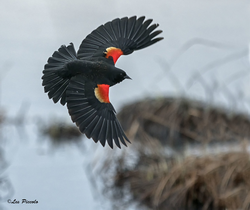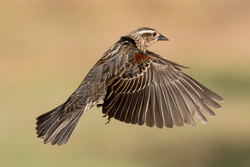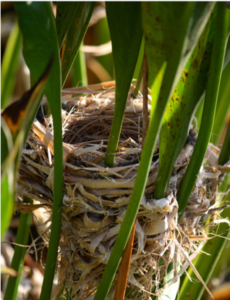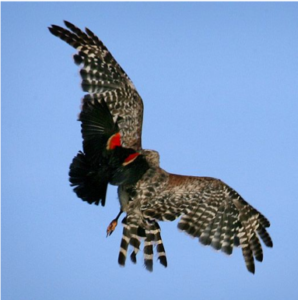


- Appearance: males and females have different coloration
- Males (left) are completely black except for red-yellow patches on their wings during summer; during winter patches fade into a yellow-orange stripe (top right)
- Females (bottom right) are streaked with light and dark brown, save for a small red patch on their wings near the shoulder, stocky body, conical bill
- Native Americans believe bird was hit on wings, making them bleed and thus turn red, are believed to bring spiritual awareness
- Local belief says, if a red-winged blackbird comes flitting across someone’s path, it is a symbolism of good luck and signals a big change in life
- Length: 7-9 inches (about .5 feet)
- Wingspan: 12-16 inches (about 1 foot)
- Status: common, but threatened by habitat loss and pesticide use
- Protected under Migratory Bird Act – one faces up to $250,000 penalty or even jail time for killing a red-winged blackbird
- Habitat
- Fresh and saltwater marshes, wooded areas along waterways, lakes, ponds, meadows, crop fields, pastures, wet roadsides
- Bird houses and feeders attract red-winged blackbirds
- One of the most abundant native birds in North America (and most well-studied)
- Found across year-round across United States and seasonally in Canada and Mexico (although Mexico can also have year-round populations)
- However, populations have declined ~30% between 1966 and 2014
- Diet
- Mainly insects in summer, mainly seeds in winter, also eat berries
- Forage on ground for caterpillars, worms, spiders, and snails or on the fly for beetles, mayflies, and grasshoppers
- Sometimes probe aquatic plants to search for insects hidden in their base
- Important for controlling native pest populations in natural ecosystem
- In nesting territories, males often declare “war” against marsh wrens, and they destroy and eat each other’s eggs
- Migration
- In Long Island and most of U.S., red-winged blackbirds are residential
- Some populations are migratory, breeding in Canada during summer and overwintering in Mexico
- Strong, agile fliers – some red-winged blackbirds migrate over 800 miles
- In winter, forage in flocks with other blackbirds and different species of songbirds
- Large flocks with thousands or millions of birds may damage grain crops such as corn, sunflower, and rice
- Measure used to control and repel birds from crops have now been a major reason for deaths of adult red-winged blackbirds
- Nesting
- Breed in marshland habitat or areas near a body of water

- Both males and females have been known to have multiple mates (sometimes 5+)
- Up to 15 females may nest in one male’s territory
- This may be a result of habitat loss, as the birds must adapt to breeding in smaller patches of land
- During much of breeding season male is found on high perch singing to attract a mate or guarding his territory
- Females wind stringy plant material around several close, upright stems of marsh grasses to build nest, line nest platform with wet leaves and mud, grass and down feathers sit at top
- Average brood is 2-4 blue-green/grey eggs with black/brown markings, females may lay second clutch
- Both parents care for young – most of the time females feed while males protect
- Sometime both males and females gang up to drive away intruders

- Males aggressively defend territory – attack hawks flying over nest and shriek at approaching humans
- May swoop down on humans until they leave nesting territory
- Hatchlings leave nest after about two weeks
- Fledglings learn to fly after about five weeks
- Average lifespan about 2-4 years, but oldest red-winged blackbird was about 16 years old
- Breed in marshland habitat or areas near a body of water






